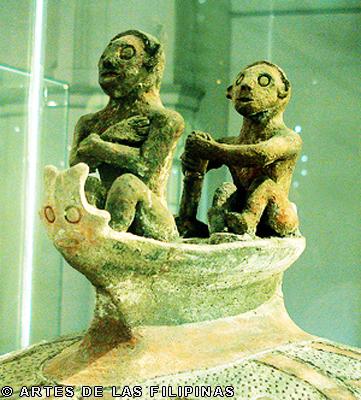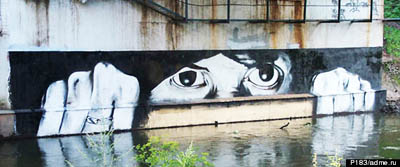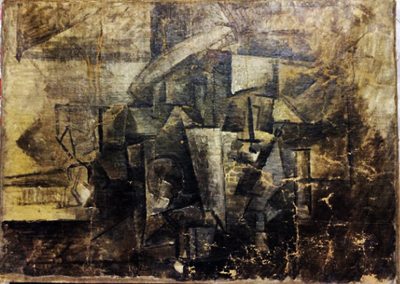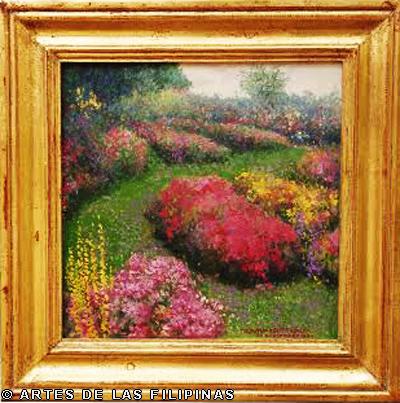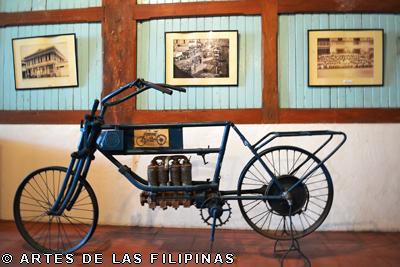Roberto Chabet at West Gallery and Finale Art File
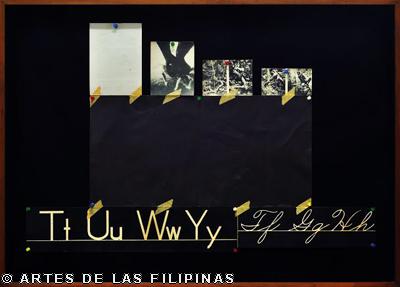
Roberto Chabet at West Gallery
and Finale Art File
By: Jack Sotto
August 2014— This year marks the 50th anniversary of Roberto Chabet as an artist. To commemorate this milestone, a series of exhibitions is running until January 2012. It began with highly anticipated shows presented by Osage Art Foundation in Hongkong and the Institute of Contemporary Arts in Singapore and continues with exhibits in several Manila galleries. The various shows can be seen as retrospective in cumulative installments.
Considered a pioneer in conceptual art in the Philippines, Chabet (b. 1937) has produced thousands of works, from drawings, paintings, collages to sculptures and installations, the majority of which have been documented in the Chabet Archive, a comprehensive undertaking initiated by Ringo Bonoan in conjunction with the Lopez Museum.
Chabet escapes easy categorization because the depth and breadth of his oeuvre is enormous. His conceptualism takes on whatever chameleonic medium is most aprops. He balances high-art gravitas and Duchampian puckishness.
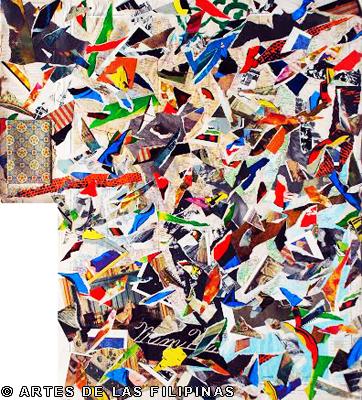
Chabet has also been an influential teacher, mentoring two generations of artists at the University of the Philippines. He has also spearheaded provocative that have questioned the nature, history.
The first two Manila shows were at West Gallery and Finale Art File, which have had long associations with Chabet. Ziggurat at West Gallery straddles two timeframes, the 1970s – 1980s and 2010. Chabet, who works serially to explore, finesse, and maximize an idea, moors these drawings, collages, and paintings in the form of the ziggurat.
The ziggurat is an ancient Mesopotamian rectangular stepped tower. With a marker, Chabet outlines the form on paper in several drawings that are dated 1971, explicating it in a number of ways. He is making marks, but with elan and a sure hand.
For the collages (1979 – 1980) he adopts the pyramidal structure of the ziggurat with a vertical or horizontal orientation. Unlike, say, Picasso who cut out newspapers to represent a journal or incorporated a caned seat to mimic a chair, Chabet simply juxtaposes various elements, mostly ephemera, found materials and residue of the qoutidian: letters and office envelopes, vinyl sleeves, post-cards, photograps, clippings, movie stills, alphabet toppers, and book pages. They are usually pasted or held together by tape and colored push-pins.
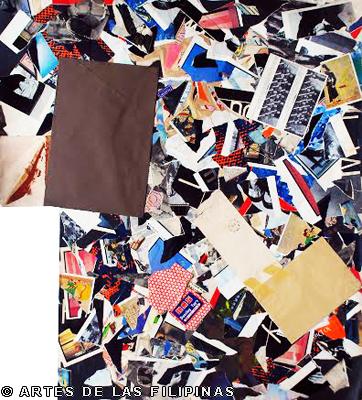
The approach is free association that is in varying parts autobiographical, nostalgic, and erudite. King Kong is the titular character in a trio of three-tiered collages. Stills from the original 1933 movie are incorporated in the collages, along with photograps and art reproductions, blank and colored pieces of paper and recurrent alphabet toppers. In one collage, the figure of the giant ape falls froma top the Empire State buildings ziggurat pinnacle.
Chabet lays the images and non-images side by side, almost like a film editor. The result is far from mustry or precious; it exudes an ineffable loveliness.
The closet allusion to Mesopotamia in Untitled with Sphinx, in which an old clipping of the Egyptian monument is one of the four rectangles in boxed frame. In For Kiko Santamaria, three simple envelopes of increasing sizes – an airmail envelop, a black one and an orange one – are pinned sideways and joined together tenuously by tape. At first blush, it is reminiscent of a 19th – century trompe l’oeil painting.
In 2010, Chabet revisits the ziggurat in a new series of acrylic on canvas works. Shaped like ziggurat and framed by wood, each painting is composed of one, three, and five individual blocks of single Modrianesque primary colors plus black and white. They are solidly architectonic. Chabet’s variations of bold colors is less Broadway boogie-woogie and more stately.
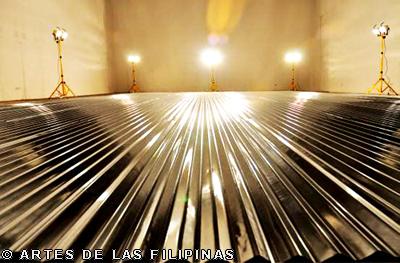
Onethingafter another (2011)
Onethingafteranother, the title of Chabet’s 2011 three part installation at Finale, could well apply to his collages. But here the shows piece de resistance is immense in size.
On the 208 square – meter ground floor of the gallery (a former warehouse), Chabet had 70 plain G.I. sheets laid on floor one after another, conforming to the space’s dimensions. He had seven flood lamps on stands installed on all sides.
Chabet has often favored ordinary, industrial materials, usually pre fab and store bought, like plywood and clipboards. Minimalists like Donald Judd were champions of such homely anti-art materials.
The installation looked barebones. The sheets covered every inch of the floor like a carpet, except at the sides. The viewer had to move precariously around the area. The piece had an ineluctable sculptural presence. The lights accentuated the materiality of the sheets. The uniform curves of the corrugations evinced an undulating pattern. Thier mettalic sheen was gray and unadorned.
Illumination was also used to dramatic effect. Light and darkness modulated the surfaces. This is the roofing material of many humble Filipino houses, glaring under the hot sun. One can go a poetic step further and look at them as if they were illusions – ocean waves or sand dunes, perhaps.
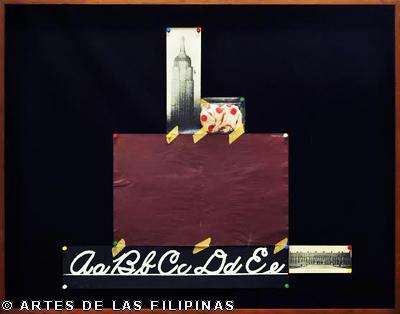
The upper galleries were the site of twin Flavin – flavored neon – light pieces. Neon has been part of Chabet’s repertoire since the 1980s. In the first gallerry the phrase “onethingafteranother” in neon had been placed a top an altar – like wooden slab. The second gallery was dominated by “imageafterimage” installed in the same manner. The phrases are words strung together and mean what they mean, quite matter of fact, but with a personal resonance.
Both rooms were bathed in red light emanating from the neon tubes. Light and space are the themes. The neon objects seemed to dematerialized, as the light emanating from them overpowered the darkened rooms. The effect was a monastic quietude.
With the first two of Chabet’s Manila shows over, seven more are in the offing, more reasons to understand one of the most stimulating minds in contemporary Filipino art.
This article first appeared at the May-June issue of Asia Art News in 2011. With the permission of the magazine, the same article appears in this issue of Artes de las Filipinas.
Jacinto Sotto holds a BFA in Painting from the College of Fine Arts, University of the Philippines, Diliman. As a student he participated in several oneman shows at the Cultural Center of the Philippines, notably “Portfolio” and “On Color”. In 1977 he was named one of the CCP’ Thirteen Artists. He held his first oneman show in 1978 at the Sining Kamalig. Since then he has mounted five solo exhibits, most recently at Finale Art Gallery and Magnet. He was an award-winning creative director at McCann Erickson, which was the No.1 ad agency of the 80s and 90s. He has contributed articles and reviews for Philippine Art Supplement, BluPrint, Media (a regional magazine on marketing communications), and Asian Art News, the only English magazine devoted to Asian Art in the world.







